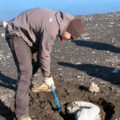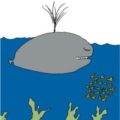
Atmospheric scientists have long suspected that microscopic aerosol particles from industrial processes increase the brightness of clouds, resulting in greater reflection of sunlight and cooling of Earth’s climate. However, this supposition is based on model calculations rather than observations, and these model calculations are very uncertain.
Now, scientists at the U.S. Department of Energy’s Brookhaven National Laboratory and Purdue University have combined satellite measurements of cloud brightness, water content, and other variables with model calculations of atmospheric aerosols to demonstrate the brightening effect. This effect, described in the February 19, 2002 issue of the Proceedings of the National Academy of Sciences, should be accounted for in assessing the magnitude of global climate change, the researchers say.
“We’re not saying that aerosols can counteract the greenhouse effect,” said lead scientist Stephen Schwartz, an atmospheric chemist at Brookhaven, “but rather that we need to know how much of a cooling effect they have so we have a clearer picture of the greenhouse effect. To whatever extent aerosols are offsetting greenhouse warming, then the offset is the unseen part of the greenhouse ‘iceberg,'” he said.
One difficulty in measuring the effect of aerosols is knowing their concentration. Aerosols such as sulfur compounds result from emissions by fossil-fuel-burning power plants and other industrial processes. They are typically found in the lowest three to four kilometers above Earth’s surface and precipitate out of the atmosphere, typically in about a week. “Because of this short residence time, aerosols are highly variable as a function of location and time, which makes it tough to measure their concentrations on a global scale,” Schwartz said.
Schwartz’s team has been working for more than a decade to develop and refine a “chemical transport model” to calculate aerosol distribution. The model uses archived weather data and weather prediction models to track the distribution of aerosols from industrial sources to various parts of the atmosphere. “This model is the key to knowing where and when to look for the aerosol effect,” Schwartz said.
By analyzing data from the model, the Brookhaven-Purdue team identified two one-week episodes during April 1987 when the modeled concentration of sulfate aerosol over the North Atlantic Ocean – far from any local sources of aerosol emissions – increased significantly and then decreased over the course of each week. These large variations in aerosol concentration and the fact that there were no high-atmosphere (obscuring) clouds during these events made them ideal episodes for studying the effect of aerosols on cloud brightening.
The findings show that, for a given liquid water path, cloud reflectivity was indeed higher on the days with higher aerosol content than on the days with lower aerosol levels. “If the effect is as widespread as we think it is, it would produce quite a substantial cooling effect on climate,” Schwartz said. “This new study,” he added, “provides a method of quantifying the phenomenon globally over the past 15 years using archived satellite data. Once this is done, we will have a much better idea of the true magnitude of the greehnouse effect.”
Could aerosols be deliberately employed to offset the greehnouse effect? “This is an attractive thought,” Schwartz said, “but it cannot work in the long run – because aerosols are so short-lived in the atmosphere, whereas greenhouse gases accumulate over time. An ever increasing amount of aerosols would be required. We’d never solve the long-term problem.”
Also, says Schwartz, the aerosol effect may have a different geographical distribution from the greenhouse effect, and “the consequence of this mismatch is unknown.” One key to assessing the overall impact of aerosols, he said, will be further development of the satellite-based measurements.








Comments are closed.